Papers by Thulani L Phakathi
North-West University (South Africa), 2018

arXiv (Cornell University), Jun 13, 2021
Quality of Service (QoS) is now regarded as a requirement for all networks in managing resources ... more Quality of Service (QoS) is now regarded as a requirement for all networks in managing resources like bandwidth and avoidance of network impairments like packet loss, jitter, and delay. Media transfer or streaming would be virtually impossible if QoS parameters were not used even if the streaming protocols were perfectly designed. QoS Scheduling classes help in network traffic optimization and the priority management of packets. This paper presents an analysis of QoS scheduling classes using video traffic in a MANET. The main objective was to identify a scheduling class that provides better QoS for video streaming. A simulation was conducted using NetSim and results were analyzed according to throughput, jitter, and delay. The overall results showed that extended real-time Polling Service (ertPS) outperformed the other classes. ertPS has hybrid features of both real-time Polling Service (rtPS) and Unsolicited Grant Service(UGS) hence the enhanced performance. It is recommended that ertPS scheduling class should be used in MANET where QoS consideration is utmost particularly in multimedia streaming applications.
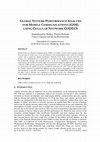
arXiv (Cornell University), Jun 30, 2021
Global System for Mobile Communications (GSM) is a cellular network that is popular and has been ... more Global System for Mobile Communications (GSM) is a cellular network that is popular and has been growing in recent years. It was developed to solve fragmentation issues of the first cellular system, and it addresses digital modulation methods, level of the network structure, and services. It is fundamental for organizations to become learning organizations to keep up with the technology changes for network services to be at a competitive level. A simulation analysisusing the NetSim tool in this paper is presented for comparing different cellular network codecsfor GSM network performance. Theseparameters such as throughput, delay, and jitter are analyzed for the quality of service provided by each network codec. Unicast application for the cellular network is modeled for different network scenarios. Depending on the evaluation and simulation, it was discovered that G.711, GSM_FR, and GSM-EFR performed better than the other codecs, and they are considered to be the best codecs for cellular networks.These codecs will be of best use to better the performance of the network in the near future.

arXiv (Cornell University), Oct 5, 2020
All networks must provide an acceptable and desirable level of Quality of Service (QoS) to ensure... more All networks must provide an acceptable and desirable level of Quality of Service (QoS) to ensure that applications are well supported. This becomes a challenge when it comes to Mobile ad-hoc networks (MANETs). This paper presents a security framework that is QoS-aware in MANETs using a network protocol called Optimized Link State Routing Protocol (OLSR). Security & QoS targets may not necessarily be similar but this framework seeks to bridge the gap for the provision of an optimal functioning MANET. This paper presents the various security challenges, attacks, and goals in MANETs and the existing architectures or mechanisms used to combat security attacks. Additionally, this framework includes a security keying system to ascertain QoS. The keying system is linked to the basic configuration of the protocol OLSR through its Multi-point Relays (MPRs) functionality. The proposed framework is one that optimizes the use of network resources and time.
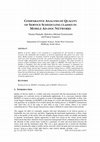
Computer Science & Information Technology (CS & IT), 2021
Quality of Service (QoS) is now regarded as a requirement for all networks in managing resources ... more Quality of Service (QoS) is now regarded as a requirement for all networks in managing resources like bandwidth and avoidance of network impairments like packet loss, jitter, and delay. Media transfer or streaming would be virtually impossible if QoS parameters were not used even if the streaming protocols were perfectly designed. QoS Scheduling classes help in network traffic optimization and the priority management of packets. This paper presents an analysis of QoS scheduling classes using video traffic in a MANET. The main objective was to identify a scheduling class that provides better QoS for video streaming. A simulation was conducted using NetSim and results were analyzed according to throughput, jitter, and delay. The overall results showed that extended real-time Polling Service (ertPS) outperformed the other classes. ertPS has hybrid features of both real-time Polling Service (rtPS) and Unsolicited Grant Service(UGS) hence the enhanced performance. It is recommended that ...
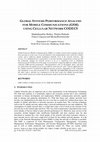
Computer Science & Information Technology (CS & IT), 2021
Global System for Mobile Communications (GSM) is a cellular network that is popular and has been ... more Global System for Mobile Communications (GSM) is a cellular network that is popular and has been growing in recent years. It was developed to solve fragmentation issues of the first cellular system, and it addresses digital modulation methods, level of the network structure, and services. It is fundamental for organizations to become learning organizations to keep up with the technology changes for network services to be at a competitive level. A simulation analysisusing the NetSim tool in this paper is presented for comparing different cellular network codecsfor GSM network performance. Theseparameters such as throughput, delay, and jitter are analyzed for the quality of service provided by each network codec. Unicast application for the cellular network is modeled for different network scenarios. Depending on the evaluation and simulation, it was discovered that G.711, GSM_FR, and GSM-EFR performed better than the other codecs, and they are considered to be the best codecs for cel...
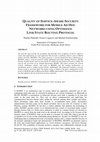
ArXiv, 2020
All networks must provide an acceptable and desirable level of Quality of Service (QoS) to ensure... more All networks must provide an acceptable and desirable level of Quality of Service (QoS) to ensure that applications are well supported. This becomes a challenge when it comes to Mobile ad-hoc networks (MANETs). This paper presents a security framework that is QoS-aware in MANETs using a network protocol called Optimized Link State Routing Protocol (OLSR). Security & QoS targets may not necessarily be similar but this framework seeks to bridge the gap for the provision of an optimal functioning MANET. This paper presents the various security challenges, attacks, and goals in MANETs and the existing architectures or mechanisms used to combat security attacks. Additionally, this framework includes a security keying system to ascertain QoS. The keying system is linked to the basic configuration of the protocol OLSR through its Multi-point Relays (MPRs) functionality. The proposed framework is one that optimizes the use of network resources and time.
International Journal of Digital Information and Wireless Communications, 2019

2016 International Conference on Computational Science and Computational Intelligence (CSCI), 2016
Vehicular ad hoc network (VANET) is an emerging network technology with the goal of providing pub... more Vehicular ad hoc network (VANET) is an emerging network technology with the goal of providing public safety, traffic coordination and infotainment for the comfort of passengers in moving vehicles. However, it faces the challenge of not providing the expected quality of service (QoS) when streaming videos online. This challenge emanate from the variable topology infrastructure caused by intrinsic high mobility nodes and dynamic environments of VANETs. A better QoS in video applications can possibly be achieved if suitable routing protocols (RPs) is/are used. Hence, this paper compared and analyzed four existing routing protocols in VANETs. The objective was to identify an efficient RPs that can deliver better QoS for video streaming applications with respect to number of nodes used. A simulation was conducted using OPNET 14.5 Modeler and results analyzed with respect to throughput, delay and routing traffic received. Results shows that OLSR performance is better when few nodes are used and AODV shows better service when many nodes are used, thereby guaranteeing the user high quality of video when streaming online. Based on the results, it would be recommended that OLSR and AODV be used as hybrid protocol to provide better QoS for video streaming in VANETs.
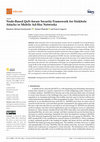
Telecom
Most networks strive to provide good security and an acceptable level of performance. Quality of ... more Most networks strive to provide good security and an acceptable level of performance. Quality of service (QoS) plays an important role in the performance of a network. Mobile ad hoc networks (MANETs) are a decentralized and self-configuring type of wireless network. MANETs are generally challenging and the provision of security and QoS becomes a huge challenge. Many researchers in literature have proposed parallel mechanisms that investigate either security or QoS. This paper presents a security framework that is QoS-aware in MANETs using a network protocol called optimized link state routing protocol (OLSR). Security and QoS targets may not necessarily be similar but this framework seeks to bridge the gap for the provision of an optimal functioning MANET. The framework is evaluated for throughput, jitter, and delay against a sinkhole attack presented in the network. The contributions of this paper are (a) implementation of a sinkhole attack using OLSR, (b) the design and implementa...
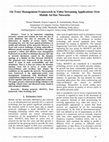
— Trust is an important computing networks concept and remains an issue not just in social platfo... more — Trust is an important computing networks concept and remains an issue not just in social platforms but also in networks in the deliverance of Quality of service (QoS). Video Streaming has, over the years gained prominence in mobile and vehicular ad hoc networks. However, it is faced with several challenges of being vulnerable to different attacks and poor QoS. Therefore, this paper proposed a robust and efficient trust management framework in an effort to eliminate the poor QoS due to network detriments caused by the dynamic topology of a Mobile Ad Hoc Network (MANET). The proposed trust framework in the network is aimed to assist in node accountability and QoS attainment. That is, it does not remove the dynamic topology issue but it strives to attain nodes' trustworthiness and excellent QoS despite the conditions set out against the network. The proposed trust framework is the application-centric trust management framework with distributed trust computations (AppTrusFram). It merges the concept of trust together with QoS in an application scenario. The paper present a theoretical-design solution to the topology related issues and discussed issues found in other proposed solutions.











Uploads
Papers by Thulani L Phakathi